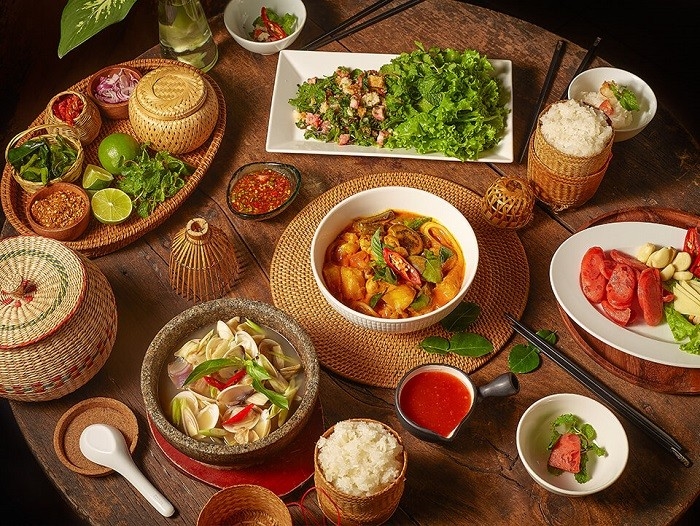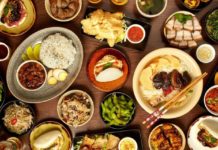Lao cuisine is known for its unique flavors, fresh ingredients, and colorful presentations. It is a significant aspect of Lao culture and lifestyle, reflecting the country’s agricultural abundance and culinary heritage. Here are some key points about Lao cuisine:
- Fresh Ingredients: Lao cuisine heavily relies on fresh, locally sourced ingredients, such as herbs, vegetables, and meats. The extensive use of fresh herbs and spices, such as lemongrass, galangal, coriander, and mint, give Lao dishes their distinct and aromatic flavors.
- Fresh, locally sourced ingredients are at the heart of Lao cuisine. Lao dishes often feature an abundance of herbs and spices that are used to create distinctive and aromatic flavors. Herbs and spices such as lemongrass, galangal, coriander, mint, and other locally available ingredients are used to add depth, complexity, and freshness to Lao dishes.
- Lemongrass, for example, is a common ingredient in many Lao soups, stews, and curries, imparting a fragrant citrusy flavor. Galangal, a root similar to ginger but with a unique taste, is often used in Lao stir-fries and soups for its slightly spicy and floral notes. Coriander, both the leaves and roots, is used as a flavor enhancer in many Lao dishes, adding a fresh and earthy taste. Mint is also commonly used in Lao cuisine, adding a cool and refreshing flavor to salads, soups, and noodle dishes.
- The use of fresh herbs and spices is integral to the unique and complex flavors of Lao cuisine, and it reflects the importance of locally sourced ingredients in Lao culinary traditions. It also showcases the country’s rich biodiversity and the abundance of fresh produce available in Laos, making Lao cuisine a celebration of the natural flavors of the region.
- Sticky Rice: Sticky rice, known as “khao niao,” is a staple in Lao cuisine and is often served with almost every meal. It is typically eaten with fingers and used to scoop up other dishes. Sticky rice is an important cultural symbol in Laos and holds significance in many traditional customs and rituals.
- Sticky rice, or “khao niao” in Lao language, is a staple food in Lao cuisine and holds a special significance in Lao culture. It is often served with almost every meal and is a central part of Lao culinary traditions.
- Sticky rice is a type of short-grain rice that has a sticky texture when cooked, and it is traditionally eaten with fingers in Laos. It is usually steamed in bamboo baskets, which gives it a distinct aroma and flavor. The sticky rice is typically rolled into small balls with the fingers and used to scoop up other dishes, such as grilled meats, spicy dips, soups, and stews. It serves as a versatile accompaniment to many Lao dishes and is an integral part of the Lao dining experience.
- Beyond its culinary significance, sticky rice also holds cultural and social significance in Laos. It is often used in traditional customs and rituals, such as religious ceremonies, festivals, and social gatherings. Sticky rice is also used in offerings to ancestors and deities as a symbol of respect and gratitude. It is deeply embedded in Lao culture and reflects the importance of rice as a staple food and cultural symbol in Laos.
- Unique Flavors: Lao cuisine is known for its bold and tangy flavors. Many dishes are characterized by a combination of sour, spicy, and salty flavors, achieved through the use of ingredients such as lime juice, fish sauce, and fermented fish or shrimp paste.
- Lao cuisine is known for its bold and distinct flavors, which are often achieved through the use of sour, spicy, and salty ingredients. Lime juice, fish sauce, and fermented fish or shrimp paste are commonly used to create these flavors in Lao dishes.
- Sourness is a prominent flavor in Lao cuisine and is often achieved using ingredients such as lime juice, tamarind, and various types of sour fruits. Sour flavors add a refreshing tanginess to Lao dishes and help balance out the richness of other ingredients.
- Spiciness is another characteristic flavor of Lao cuisine, with the use of fresh and dried chilies being common in many dishes. Chili peppers are used to add heat and depth to Lao dishes, and different types of chili peppers are used to achieve varying levels of spiciness.
- Saltiness is also an important flavor in Lao cuisine, and fish sauce, which is made from fermented fish or shrimp, is a commonly used ingredient to add saltiness to Lao dishes. Fermented fish or shrimp paste, known as “pa daek” in Lao, is also used to add a unique umami flavor to many Lao dishes.
- The combination of sour, spicy, and salty flavors creates a harmonious balance in Lao cuisine, resulting in delicious and complex taste profiles that are loved by many.
- Diverse Dishes: Lao cuisine offers a wide variety of dishes, ranging from soups and salads to stir-fries and grilled meats. Popular Lao dishes include larb (a spicy minced meat salad), tam mak hoong (a spicy green papaya salad), sin savanh (a Lao-style hot pot), and mok pa (a steamed fish dish wrapped in banana leaves).
- Lao cuisine offers a diverse range of dishes with a variety of flavors and cooking techniques. Here are some popular Lao dishes:
- Larb: Larb is a spicy minced meat salad made with either chicken, pork, or beef, mixed with roasted rice powder, lime juice, fish sauce, and fresh herbs. It is typically served with fresh vegetables and sticky rice, and the combination of tangy, spicy, and aromatic flavors makes it a beloved Lao dish.
- Tam mak hoong: Tam mak hoong is a spicy green papaya salad made with shredded unripe papaya, tomatoes, peanuts, fish sauce, lime juice, and chilies. It is a refreshing and flavorful salad with a combination of sour, spicy, and crunchy textures.
- Sin savanh: Sin savanh is a Lao-style hot pot that is popular for gatherings and special occasions. It typically consists of a boiling pot of broth in the center of the table, surrounded by an array of fresh vegetables, meats, and seafood. Diners can cook the ingredients in the broth and enjoy them with dipping sauces.
- Mok pa: Mok pa is a steamed fish dish that is wrapped in banana leaves and cooked with various herbs and spices, such as lemongrass, galangal, and dill. The fish is flavored with a mixture of spices and wrapped in banana leaves, then steamed to perfection, resulting in a fragrant and delicious dish.
- These are just a few examples of the many delicious dishes that make up Lao cuisine. Lao cuisine is known for its bold flavors, creative use of local ingredients, and unique cooking techniques, making it a delightful culinary experience for food lovers.
- Social Dining: Lao dining is often a communal and social affair, with people sharing multiple dishes and eating together. It is common for Lao meals to be served family-style, with an array of dishes placed in the center of the table for everyone to enjoy. This reflects the importance of food as a means of bringing people together in Lao culture.
- Lao dining is often a communal and social affair, with food being a means of bringing people together. Lao meals are typically served family-style, with a variety of dishes placed in the center of the table for everyone to share and enjoy. This communal style of dining fosters a sense of togetherness and allows for lively conversations and interactions among family and friends.
- In Lao culture, food is not just nourishment but also a way of expressing hospitality, generosity, and social connections. It is common for Lao families to prepare and share multiple dishes during meals, showcasing the abundance of local ingredients and the culinary skills of the cook. Lao people take pride in their food culture and often use meals as a way to celebrate special occasions, entertain guests, and strengthen social bonds.
- Furthermore, Lao dining customs often involve using fingers to eat sticky rice or to scoop up other dishes, emphasizing the tactile and interactive nature of Lao meals. This communal and social aspect of Lao dining is a significant part of the Lao lifestyle and reflects the importance of food in Lao culture beyond just sustenance, but also as a means of fostering connections and community.
- Street Food Culture: Street food is an integral part of Lao cuisine, with street vendors and markets offering a wide array of delicious and affordable food options. Lao people often enjoy street food as a quick and convenient way to satisfy their cravings or socialize with friends and family.
- Street food is indeed an integral part of Lao cuisine and culture. Lao street vendors and markets are known for offering a wide variety of delicious and affordable food options that are enjoyed by locals and tourists alike. Street food in Laos is often seen as a convenient and quick way to satisfy cravings, especially during busy days, and it is also a popular choice for socializing with friends and family.
- Lao street food is known for its diverse flavors, from spicy and tangy to savory and sweet. Popular Lao street food dishes include grilled meats, noodle soups, rice dishes, skewers, and fresh salads. Vendors often prepare the food in front of customers, adding to the interactive and lively atmosphere of street food culture in Laos.
- Street food is not only about the food itself but also about the experience and the sense of community. Lao people often gather at street food stalls or markets, sit on low stools or mats, and enjoy their meals while chatting and socializing with friends, family, and even strangers. It is a common sight to see locals sitting together, sharing food, stories, and laughter, creating a vibrant and convivial atmosphere.
- Furthermore, street food is often seen as a way to support local vendors and contribute to the local economy. Lao people take pride in their street food culture and appreciate the unique flavors and culinary heritage offered by street vendors. It is considered an authentic and cherished part of Lao lifestyle and adds to the rich tapestry of food culture in Laos.
- Sustainability: Lao cuisine places a strong emphasis on utilizing local, seasonal, and sustainable ingredients. Many traditional Lao dishes incorporate foraged ingredients, wild herbs, and locally available produce, showcasing the country’s rich biodiversity and culinary heritage.
- Lao cuisine places a strong emphasis on utilizing local, seasonal, and sustainable ingredients. Many traditional Lao dishes showcase the country’s rich biodiversity and culinary heritage by incorporating foraged ingredients, wild herbs, and locally available produce. Lao people have a deep connection with nature and the land, and this is reflected in their culinary practices.
- Foraging is a common practice in Lao cuisine, where wild herbs, vegetables, and other edible plants are gathered from the local surroundings. These foraged ingredients add unique flavors and textures to Lao dishes, giving them a distinct taste that is closely tied to the local environment. From bamboo shoots to edible flowers, wild mushrooms to riverweed, Lao cuisine celebrates the bounty of nature and incorporates it into their traditional dishes.
- In addition, Lao cuisine also heavily relies on locally available produce, such as rice, fish, vegetables, and herbs. The use of local ingredients ensures that the dishes are fresh, flavorful, and sustainable, as they are sourced from nearby areas, reducing the carbon footprint associated with transportation. It also supports local farmers and promotes local agriculture, contributing to the local economy.
- Seasonality is also an important aspect of Lao cuisine. Lao people are attuned to the changing seasons and the availability of different ingredients throughout the year. They adapt their culinary practices accordingly, using what is seasonally abundant and fresh. This ensures that Lao dishes are made with the freshest and most flavorful ingredients, and it also promotes sustainability by reducing reliance on out-of-season or imported produce.
- Overall, the emphasis on local, seasonal, and sustainable ingredients in Lao cuisine not only contributes to the unique flavors and culinary heritage of the country but also reflects the Lao people’s deep connection with nature and their commitment to sustainability and preserving their culinary traditions.
Lao cuisine is an important aspect of Lao culture and lifestyle, reflecting the country’s rich culinary traditions, fresh ingredients, and communal dining practices. It is a unique and flavorful cuisine that is cherished by the Lao people and appreciated by visitors to the country.




